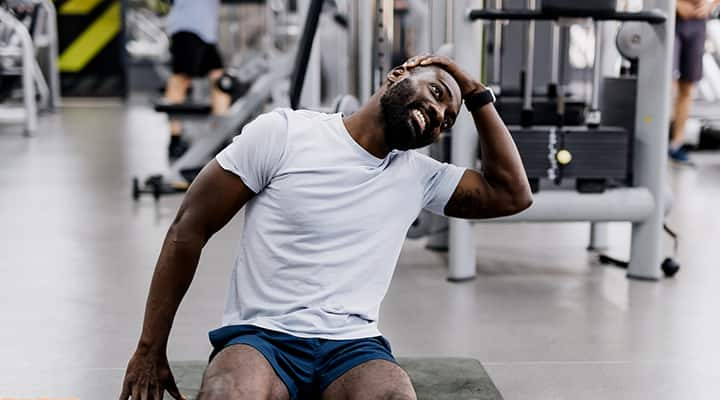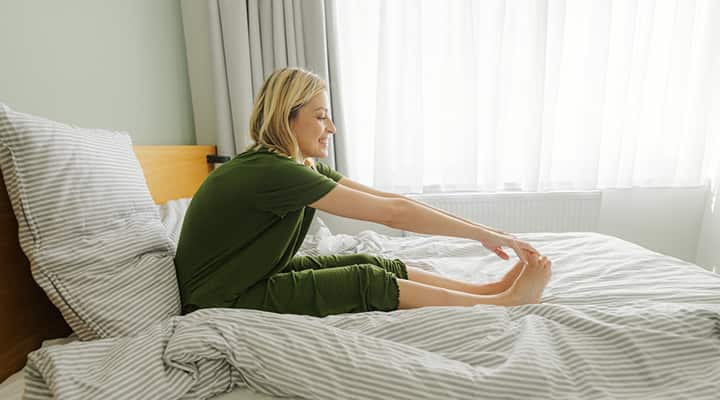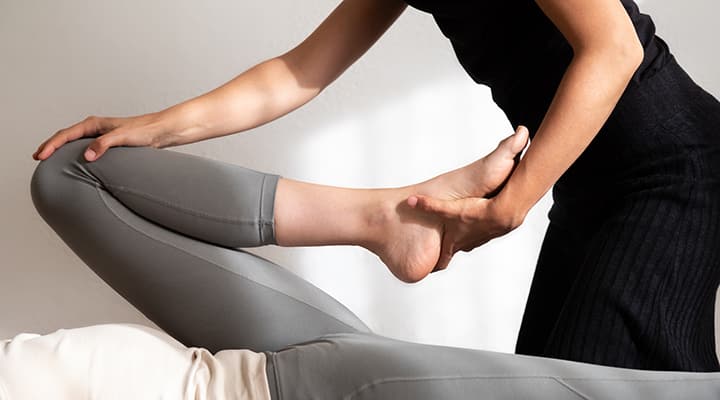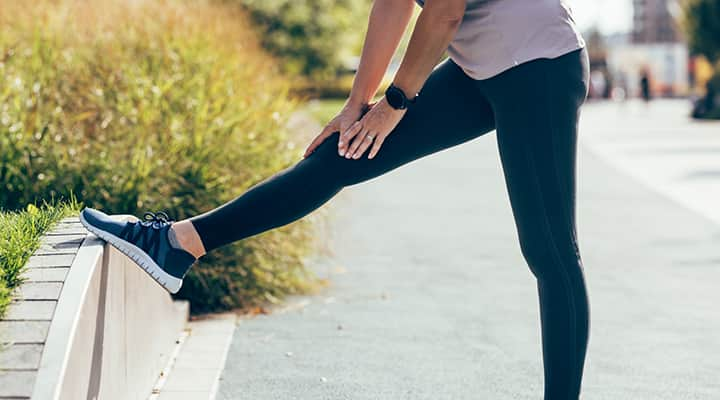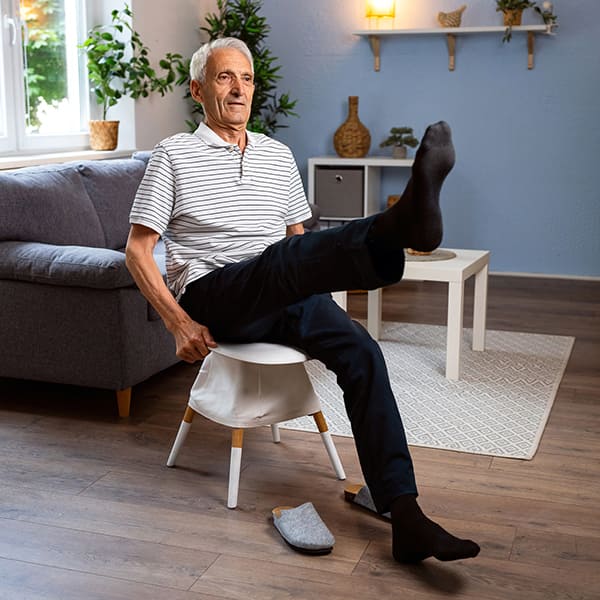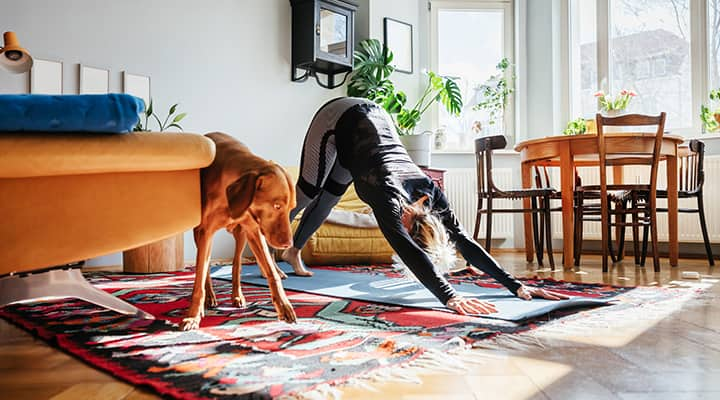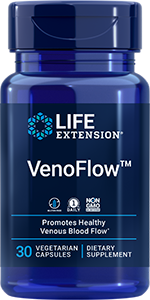
9 Daily Stretches for Beginners
Published: August 2024
There's something so satisfying about doing a deep, refreshing stretch first thing in the morning: arms raised high above your head for a full-body stretch that goes straight to your perfectly pointed toes…"ahhh!" It's an instant wake-up that takes minimal time and effort.
And even though stretching is as easy as a Sunday morning (sometimes literally), it has significant health benefits for your whole body. In fact, this daily practice is imperative for your health, especially as you age—particularly for your heart and joints.
So, why is stretching so important, and how do you make this practice a part of your wellness journey? Let's explore the health benefits, how to turn those occasional neck rolls at your desk into regular practice, plus nine beginner stretches to jumpstart your routine.
How does stretching daily support joint and heart health?
Stretching has many health benefits: it can help you manage stress, improve your posture and encourage muscle comfort. From that unwelcome crick in your neck after a day hunched over a laptop, to ankles and calves that feel tight after an uphill walk, there's not a body part that doesn't benefit from a good stretch!
However, this practice is most noteworthy for supporting your joints and cardiovascular health, and yes, these two things are related! Let's explain.
Over time, joints can become less flexible, making it harder to do simple physical activities like raising your arms over your head, bending over and touching your toes, or even walking. Lack of flexibility may impact your balance and can lead to physical discomfort, which tends to make people reduce their mobility. Unfortunately, increasingly sedentary lifestyles have a direct impact on joint health and comfort. Not getting enough movement also impacts your heart health.
Fortunately, stretching as a daily practice supports joint and heart health by gently conditioning joints and connective tissue for fluid movement, as well as supporting endothelial health, the delicate inner lining of blood vessels and arteries. Meanwhile, your cardiovascular system (blood vessels and arteries) carries blood to every cell in your body, which is no easy task, and over time it can affect endothelial health.
A stretching routine is a proactive way to help show your arteries some love. (Before you ask, no, daily stretching does not replace heart- and joint-friendly habits, like eating nutrient-rich, balanced meals, getting regular exercise, prioritizing quality sleep, and managing a healthy weight—you know, the cornerstones of head-to-toe wellness.)
How to create a daily stretching routine
Are you ready to give your joints, heart and the rest of your body the stretching they’ve been craving? Here’s how to get started.
1. Find the time
Stretching doesn’t take very long, but it’s easy to put it on the back burner. Here are a few easy ways to make sure you never skip a stretch session!
- Stretch upon waking. Check this one off your list first thing in the morning by getting in some good stretches before you chase after the rest of your day.
- Add stretching to your exercise routine. For example, if you're a runner, you're probably already doing warm-up stretches. Consider switching those up or adding some new stretches post-workout. If you're hardcore HIIT (high-intensity interval training), try cooldown stretches post-workout.
- Add stretching to your self-care routine. Make stretching a daily practice by pairing it with your “anchor” or daily habits, like before a shower or after your skin care ritual.
- Sneak them in during coffee breaks or other daily habits. Think about things you do every day, whether it’s coffee midday or even getting the mail. You can get in some good stretches while you’re waiting for the java to brew!
2. Target multiple muscle groups
Rotating your hands or ankles might feel great, but don't forget the rest of you! Aim for stretches that target your whole body (just think of the children's tune "Head, Shoulders, Knees and Toes" and make sure you're getting each of these areas, plus your back and legs, too!)
3. Get help from experts
Read on for stretches anyone can tackle, but also look outward to your community. Personal trainers, athletic friends, coaches, or an internet instructor with solid credentials all can help you check your form and offer feedback on how to target major muscle groups and allow for a full range of motion.
4. Track your stretching
Track your stretches by using a journal or try flexibility and mobility training apps, which are also chock-full of stretching routines, inspiration and more. Here are three you can check out:
- StretchIt: This app releases new flexibility and mobility training weekly classes for all levels, from beginners to advanced stretchers.
- Start Stretching: This is a great app that acts as a stretching coach for healthy people who want to improve their flexibility.
- Stretch & Flexibility at Home: Perfect for all-level stretchers who want to increase mobility and range of motion.
Consult your doctor before making any lifestyle adjustments, especially if you have a limited range of motion or are experiencing physical discomfort.
9 daily stretches for beginners
Now that you know how to establish a stretching routine, the question is, what should you be doing during that time? This is the fun part! Here are some effective stretches to get you on the road to flexibility; other than a chair, there's no equipment requirement.
Pro tip: Focus on your breathing as you perform each move—inhale through the nose; exhale through the mouth.
1. Cat-cow to child’s pose
Borrowed from yoga, this three-part stretch alternates between back rounded and concave (your body looks like a cat, then a cow), followed by child's pose.
Cat-cow
- Position yourself with hands and knees on the ground, hands under your shoulders, knees under your hips.
- Inhale, lifting your chin, chest, and seat toward the sky.
- Exhale, tucking your chin and tailbone under while rounding your spine.
Alternate between these moves with about 15 to 30 seconds in between, then lean into the next move.
Child’s pose
- Kneel on the floor, sitting back on your heels.
- Touch your forehead gently to the floor, stretching your arms out fully in front of you, elongating your torso. To modify, you can stack your hands in front of you and rest your forehead. Over time, you’ll be able to do the full pose.
2. Standing calf stretch
If you’re looking for a beginner stretch to target calf muscles and shins, this is it.
- Stand facing a wall with hands at eye level.
- Place the leg you want to stretch a step behind your other leg (you can start with either your left or right leg).
- Keep the heel of your back leg on the floor, bending the knee of the front leg until you feel a stretch in your back leg.
- To increase the stretch, bend the front knee deeper, move your back leg further back or create distance between your feet.
3. Standing chest stretch
This is another wall or doorway exercise known to increase range of motion and support strong chest muscles.
- Bend your elbows to a 90-degree angle, placing one forearm on a doorway or wall with your elbow at or slightly below shoulder height.
- Step forward until you feel a stretch across the chest and shoulder of the arm against the wall.
- Hold the stretch for 15 to 30 seconds. Repeat two to four times, alternating forearms.
4. Standing or seated traps stretch
Traps (or trapezius muscles), located in the upper back and shoulder area, are common places where people hold tension. This stretch gives you the benefits of tension relief and relaxation while standing or sitting.
- Sit up (or stand) tall, with your shoulders down and pulled back. Align your shoulders and ears.
- Place your left hand on top of your head and gently move or pull your head to the side, bringing your left ear toward your left shoulder for a side stretch.
- Hold and repeat on your right side.
Explore Our Best Joint Health Supplements
5. Standing or seated levator scapulae stretch
This stretch, which can be done seated or standing, can help with neck and upper back and postural discomfort.
- Sit up (or stand) tall, shoulders down and pulled back, with your ears stacked over your shoulders.
- Place one hand on top of your head, lining up your nose with your elbow, then gently pull your nose down toward your armpit.
- If you’re doing the movement correctly, you should feel the stretch from the base of your head and neck to the top of your shoulder blade.
6. Standing or seated hamstring stretch
One of the dynamic stretches runners do regularly is the hamstring stretch, which helps limber up the muscles that span the back of the thigh, from the hip to right below the knee.
Standing
- Place one heel in front, toes up, keeping your leg straight as you sit your hips back (imagine sitting in a chair), resting your hands on your outstretched leg.
- Switch legs and repeat. Hold the count for 10-15 seconds.
Seated
- Sit on the front edge of a chair, both legs bent in front of you.
- Extend your left leg straight out, toes up, keeping your back flat while you lean forward.
- You should feel the stretch in the back of that left leg to know you’re doing it correctly.
- Change to the right leg and repeat.
7. Standing or lying down quad stretch
Here’s another classic leg stretch that can be done seated or lying down:
Standing
- Use a chair or wall for balance, bending one knee, so your foot is behind your thigh.
- Grab the foot and squeeze your glutes, stretching your leg back until your thighs are even.
Lying down
- Lay down on one side and bend your top leg.
- Grab your foot with your top arm, pull your thigh back, and stack it on top of the other one.
- Hold and repeat on the other side.
8. Standing or kneeling hip flexor stretch
Hip flexors help stabilize your torso, so definitely give this stretch a try. It increases mobility in your hips and back.
Standing
- Start with both feet facing straight ahead, then step one foot back.
- Raise the arm on the side of the back leg. Reach up and over your head slightly.
- To deepen the stretch, raise your upper body away from the front leg.
Kneeling
- Put one knee directly beneath your hip, bending the other leg at a 90-degree angle, foot flat on the floor.
- Squeeze your glutes on the kneeling side, tucking your hips under.
9. Kneeling or standing thoracic spine stretch
This is an excellent upper back stretch for better posture and pain reduction.
Kneeling
- Get on all fours, engaging your abs, putting your right hand behind your head.
- Exhale, reaching the elbow of your bent arm toward your opposite armpit.
- Inhale as you bring the elbow up toward the sky for a side stretch.
- Remember to reach as far as is comfortable for you to avoid strain.
Standing
- Repeat the same motion but with one hand on a chair back.
- Keep your knees slightly bent and your back flat.
Is it better to stretch in the morning or at night?
Either or both—it's up to you! Morning stretches can help relieve tension or pain from sleeping, increase blood flow, and energize your body for the day. On the other hand, nighttime stretches are great for relaxation and stress reduction at the end of the day. Muscles and joints are typically more flexible in the evening, so those stretches may yield deeper results and help prevent muscles from tightening up overnight, which can facilitate better sleep and help alleviate morning stiffness.
Experts recommend stretching for at least 30 minutes before bed to prep the body for a restful night’s sleep.
Is it okay to do stretching exercises every day?
Yes! In fact, you'll most likely only see lasting benefits from doing daily stretches. Again, start small and aim to stretch three times a day: morning, afternoon and night.
Does stretching every day support flexibility?
Yes, it does. Studies have shown that stretching is one of the best ways to help maintain and support flexibility.
For example, a review of 27 randomized controlled trials (RCT) concluded that both dynamic stretching (using movement while stretching) and static stretching (holding a stretch for a period of time) can help improve range of motion in the hamstrings.
Another small RCT with 16 dancers showed that performing stretching exercises along with flexibility exercises for eight weeks helped improve muscle comfort and range of motion.
Stretch daily practice goals
Congratulations! You now have a full-body stretch routine you can do whenever, wherever you are. If you don’t have time to do all nine stretches in one sitting, or it feels overwhelming, choose three to five stretch moves mentioned above, set a 5- to 10-minute time and get to work.
You can chat with your doctor or physical therapist to make sure these stretch moves are right for you, and get ready to reach new levels of strength, agility and motion. Now that’s a flex!
References
- Campbell TM, et al. "Stretching, Bracing, and Devices for the Treatment of Osteoarthritis-Associated Joint Contractures in Nonoperated Joints: A Systematic Review and Meta-Analysis." Sports Health. November-December 2023. https://www.ncbi.nlm.nih.gov/pmc/articles/PMC10606959/
- Giwon K, et al. "Effect of Stretching-Based Rehabilitation on Pain, Flexibility and Muscle Strength In Dancers With Hamstring Injury: A Single-Blind, Prospective, Randomized Clinical Trial." J Sports Med Phys Fitness. September 2018. https://pubmed.ncbi.nlm.nih.gov/29072027/
- Peng C, et al. "Dynamic And Static Stretching On Hamstring Flexibility And Stiffness: A Systematic Review And Meta-Analysis." Heliyon. July 2023. https://pubmed.ncbi.nlm.nih.gov/37560703/
- "10 Stretches to Do Before Bed to Improve Your Sleep." Hospital for Special Surgery. January 2021.
- "Exercising to relax." Harvard Health Publishing. July 2020. https://www.health.harvard.edu/staying-healthy/exercising-to-relax
- "The importance of stretching." Harvard Health Publishing. April 2024. https://www.health.harvard.edu/staying-healthy/the-importance-of-stretching
- "In Brief: How Do Joints Work?" National Library of Medicine. November 2021. https://www.ncbi.nlm.nih.gov/books/NBK279363/
- "A New Way to Help Your Heart: Stretch!" ClevelandHeartLab. September 2020. https://www.clevelandheartlab.com/blog/a-new-way-to-help-your-heart-stretch/
Always be in the know!
Access the latest deals, wellness news, expert health tips & more!



